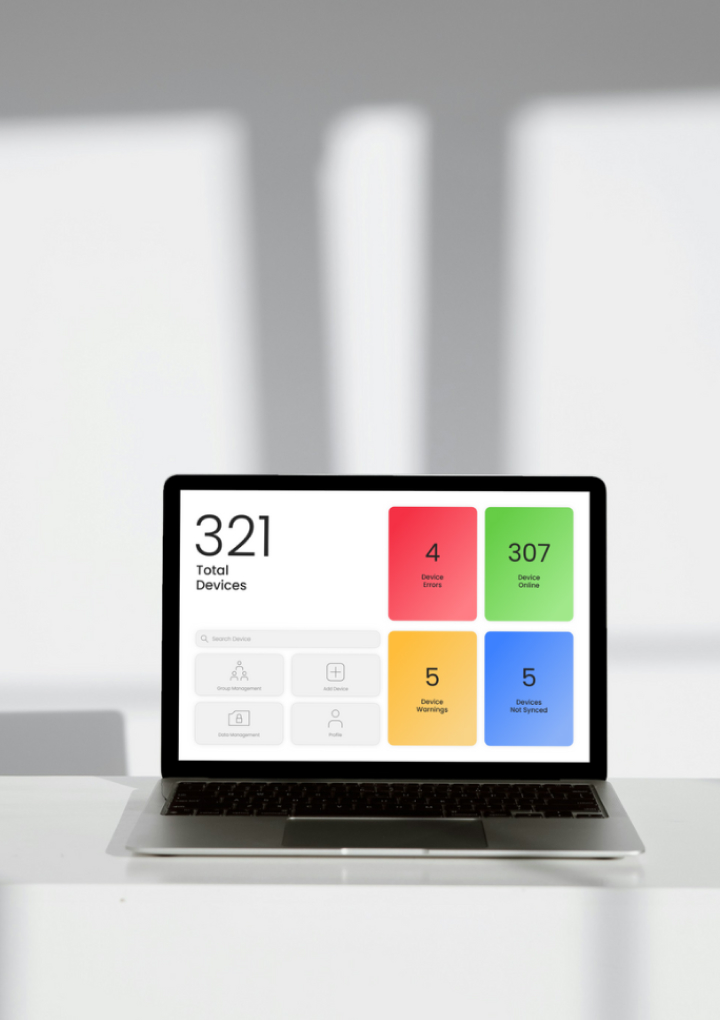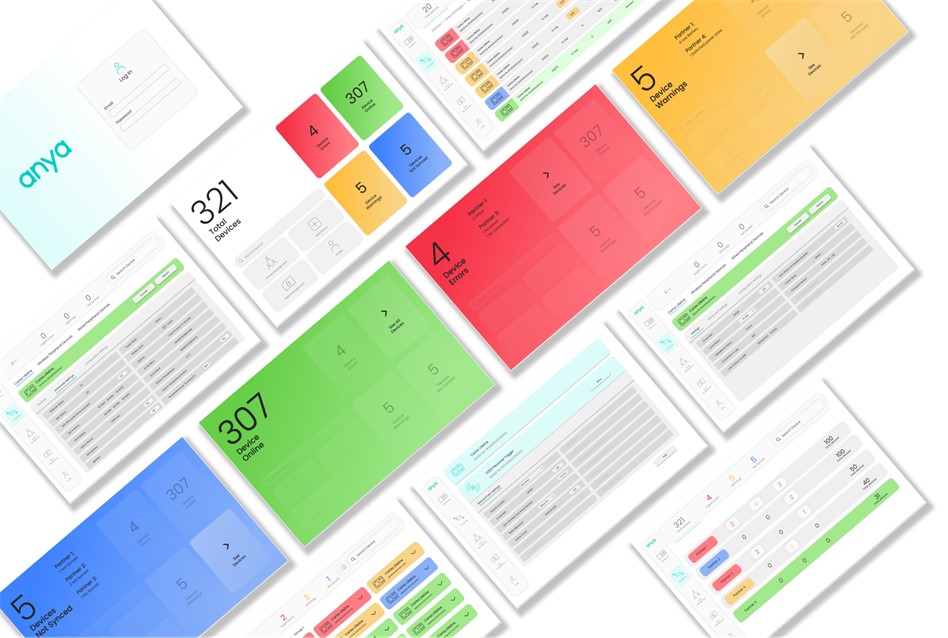UX/UI Design: Digital Management Platform:
Helping Care Providers

The brief
Bang Creations redesigned the UX/UI of ANYA’s Device Management Platform (DMP), a centralised hub for managing wearable devices in Wi-Fi-connected care home environments. The DMP streamlines device installation, maintenance, and real-time monitoring, helping care providers track the well-being of residents.
Our challenge was to create a user-friendly, visually engaging interface that enables service providers, managers, technicians, and care staff to efficiently handle device errors, configurations, and service updates.
By improving navigation, accessibility, and overall user experience, we helped enhance operational efficiency in care settings.
The bang
The team took a user-centric approach to redesign the DMP. Our goal was to simplify device management in Wi-Fi-connected care home environments while ensuring an intuitive experience for all users. We started by conducting in-depth research to identify the pain points faced by service providers, managers, technicians, and care staff when managing devices.
One of our key challenges was structuring a clear system architecture. We identified four distinct user groups, developed detailed personas, and mapped out user journeys to ensure seamless navigation and functionality. Recognising the complexity of the DMP, we focused on creating a clean, visually engaging dashboard. By using four bold colours, we ensured that critical information stood out, allowing users to quickly access what they need.
Our design process was highly iterative, with continuous feedback from the ANYA team. Through multiple refinements, we optimised the dashboard layout, navigation, and overall user experience.
The result
The redesigned Device Management Platform is now more user-friendly and intuitive, brought to life through a detailed Figma prototype. This interactive prototype allowed our client to experience the design early in the process, providing crucial feedback and enabling rapid refinements.
By streamlining user interactions and functionality, the prototype not only accelerated development but also ensured a final product that meets user needs and expectations.




UX/UI Design: Digital Management Platform:
Helping Care Providers
The brief
Bang Creations redesigned the UX/UI of ANYA’s Device Management Platform (DMP), a centralised hub for managing wearable devices in Wi-Fi-connected care home environments. The DMP streamlines device installation, maintenance, and real-time monitoring, helping care providers track the well-being of residents.
Our challenge was to create a user-friendly, visually engaging interface that enables service providers, managers, technicians, and care staff to efficiently handle device errors, configurations, and service updates.
By improving navigation, accessibility, and overall user experience, we helped enhance operational efficiency in care settings.
The bang
The team took a user-centric approach to redesign the DMP. Our goal was to simplify device management in Wi-Fi-connected care home environments while ensuring an intuitive experience for all users. We started by conducting in-depth research to identify the pain points faced by service providers, managers, technicians, and care staff when managing devices.
One of our key challenges was structuring a clear system architecture. We identified four distinct user groups, developed detailed personas, and mapped out user journeys to ensure seamless navigation and functionality. Recognising the complexity of the DMP, we focused on creating a clean, visually engaging dashboard. By using four bold colours, we ensured that critical information stood out, allowing users to quickly access what they need.
Our design process was highly iterative, with continuous feedback from the ANYA team. Through multiple refinements, we optimised the dashboard layout, navigation, and overall user experience.
The result
The redesigned Device Management Platform is now more user-friendly and intuitive, brought to life through a detailed Figma prototype. This interactive prototype allowed our client to experience the design early in the process, providing crucial feedback and enabling rapid refinements.
By streamlining user interactions and functionality, the prototype not only accelerated development but also ensured a final product that meets user needs and expectations.
UX/UI Design: Digital Management Platform:
Helping Care Providers
The brief
Bang Creations redesigned the UX/UI of ANYA’s Device Management Platform (DMP), a centralised hub for managing wearable devices in Wi-Fi-connected care home environments. The DMP streamlines device installation, maintenance, and real-time monitoring, helping care providers track the well-being of residents.
Our challenge was to create a user-friendly, visually engaging interface that enables service providers, managers, technicians, and care staff to efficiently handle device errors, configurations, and service updates.
By improving navigation, accessibility, and overall user experience, we helped enhance operational efficiency in care settings.
The bang
The team took a user-centric approach to redesign the DMP. Our goal was to simplify device management in Wi-Fi-connected care home environments while ensuring an intuitive experience for all users. We started by conducting in-depth research to identify the pain points faced by service providers, managers, technicians, and care staff when managing devices.
One of our key challenges was structuring a clear system architecture. We identified four distinct user groups, developed detailed personas, and mapped out user journeys to ensure seamless navigation and functionality. Recognising the complexity of the DMP, we focused on creating a clean, visually engaging dashboard. By using four bold colours, we ensured that critical information stood out, allowing users to quickly access what they need.
Our design process was highly iterative, with continuous feedback from the ANYA team. Through multiple refinements, we optimised the dashboard layout, navigation, and overall user experience.
The result
The redesigned Device Management Platform is now more user-friendly and intuitive, brought to life through a detailed Figma prototype. This interactive prototype allowed our client to experience the design early in the process, providing crucial feedback and enabling rapid refinements.
By streamlining user interactions and functionality, the prototype not only accelerated development but also ensured a final product that meets user needs and expectations.




